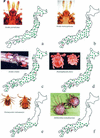Genetic identification of rickettsiae isolated from ticks in Japan
- PMID: 12037083
- PMCID: PMC130657
- DOI: 10.1128/JCM.40.6.2176-2181.2002
Genetic identification of rickettsiae isolated from ticks in Japan
Abstract
Following the description in Japan of Japanese spotted fever, caused by Rickettsia japonica, a search for the vector of this disease led to the isolation of several rickettsiae from various tick species. Sixty-three rickettsial isolates were obtained from six different tick species, and six type strains were described by PCR and monoclonal antibody testing. We identified these six strains by amplification and sequencing of the genes encoding 16S rRNA and citrate synthase. We confirmed that the isolates from Dermacentor taiwanensis and Haemaphysalis flava ticks were R. japonica isolates. In Ixodes ovatus, Ixodes persulcatus, and Ixodes monospinosus, we identified a Rickettsia identical or closely related to Rickettsia helvetica, a species that is pathogenic for humans and that to date has only been found in Europe. Finally, we identified a new genotype of unknown pathogenicity, genotype AT, that was isolated from Amblyomma testudinarium ticks and that is closely related to a Slovakian genotype obtained from Ixodes ricinus ticks.
Figures


References
-
- Felsenstein, J. 1989. PHYLIP—phylogeny inference package (version 3.2). Cladistics 5:164-166.
-
- Fujita, H., N. Takada, E. Isogai, Y. Watanabe, and T. Ito. 2000. Isolation of spotted fever group rickettsiae from Ixodes persulcatus ticks in the central part of Hokkaido, Japan. Med. Entomol. Zool. 51:55-58.
-
- Fujita, H., N. Takada, and Y. Tsuboi. 1996. Survey of ixodid ticks (Acarina: Ixodidae) and tick-borne spotted fever group rickettsiae in Tokunoshima Island, Japan. Med. Entomol. Zool. 47:15-21.
MeSH terms
Substances
LinkOut - more resources
Full Text Sources
Molecular Biology Databases

